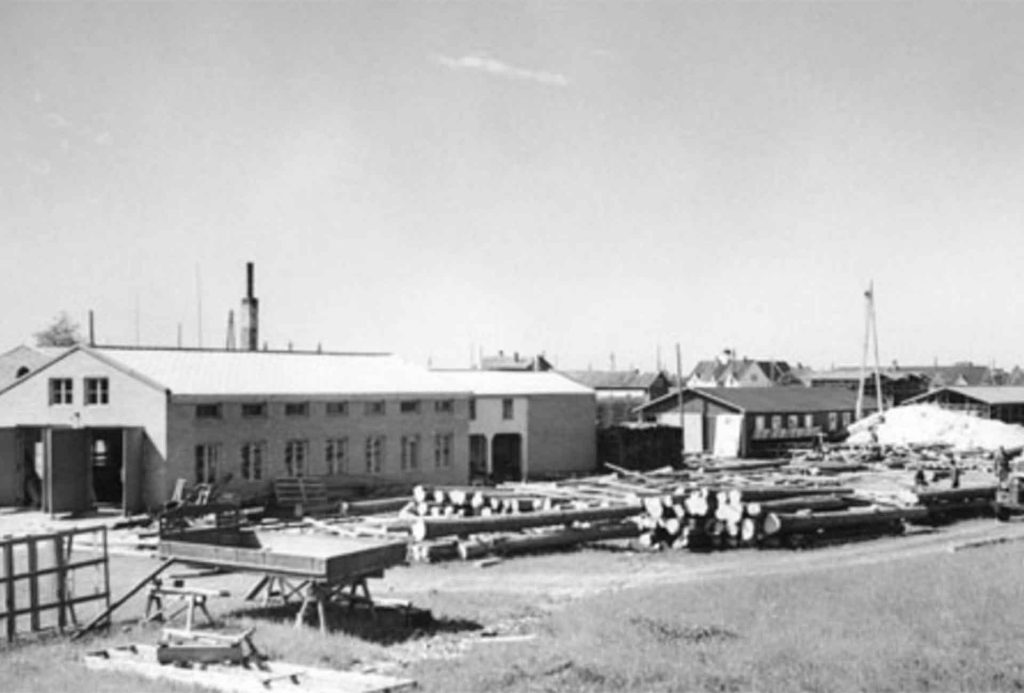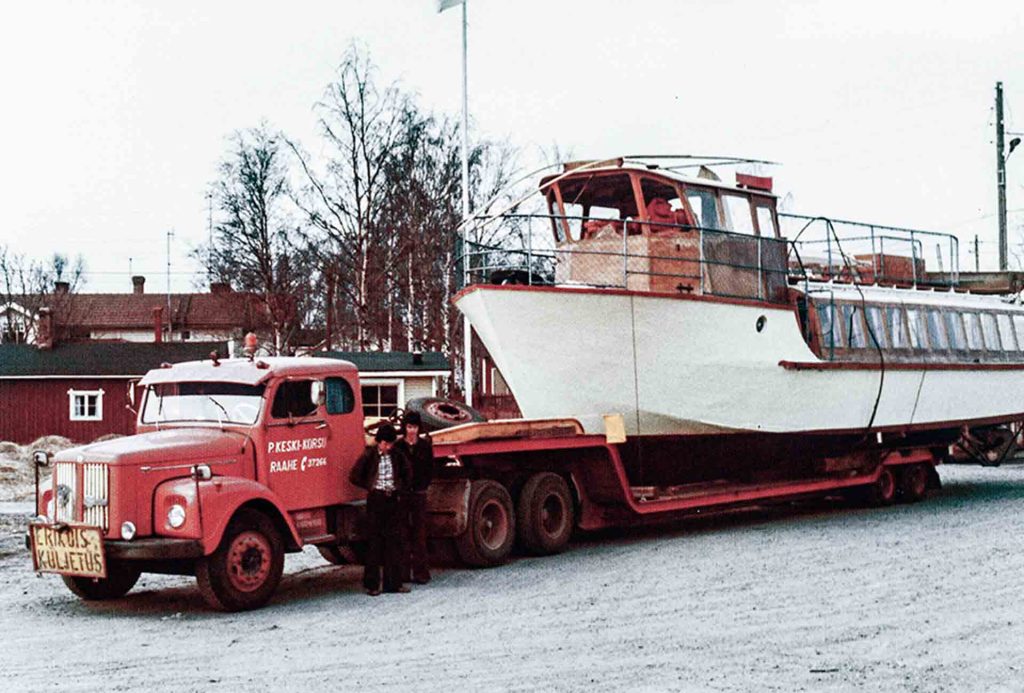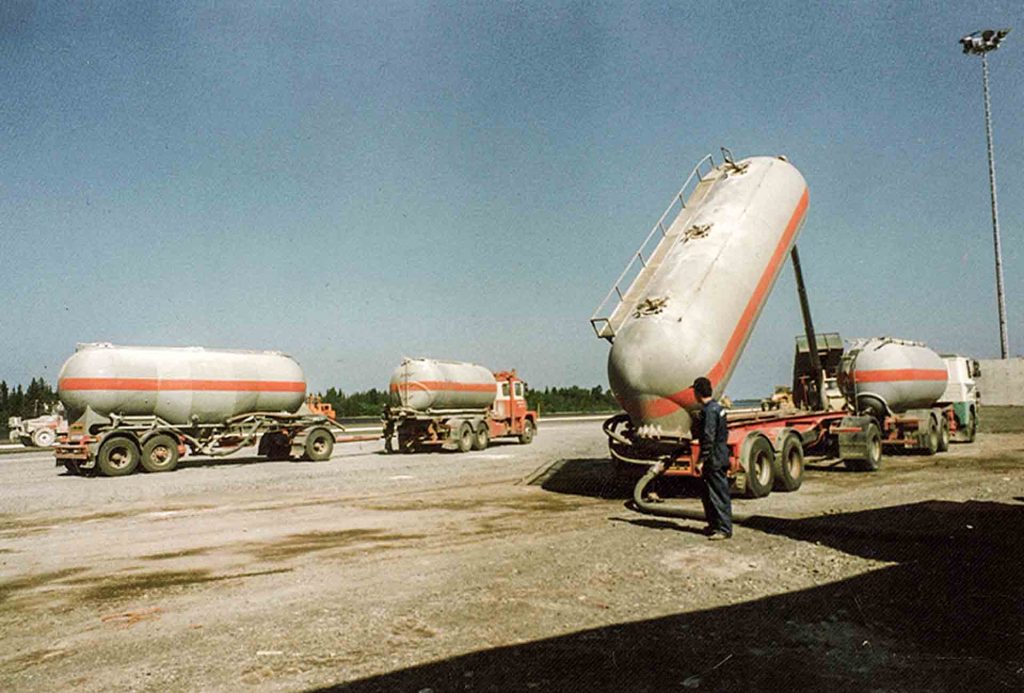Korsu »
History

— 1920s
Korsu story begins in 1923, when the carpenter Yrjö Keski-Korsu built a fence at the back of his yard and started working as an independent carpenter. The workshop produced doors, windows, furniture, and other carpentry products.

— 1930s
In the 1930s demand increased, and Yrjö's sons Eino, Yrjö and Väinö joined the business. The company was equipped with the first machine that could saw, plan, mill and drill. In 1935, Yrjö Keski-Korsu was granted the first traffic license for a passenger car. This can be considered the beginning of the company's transport operations.

— 1940-luku
During the war, the company operated on a small scale and manufactured skis for the needs of the Defense Forces, among other things. As the company's founder, Yrjö Keski-Korsu passed away in 1941, his children took responsibility for the company.

— 1950s
The end of war reparations caused a great change in the company's operations. The workforce was reduced, and the company had to look for new fields of operation. In addition to manufacturing wood products, they decided to start construction activities in Raahe and its surroundings.
In the early 1950s, truck transports were started not only for our own needs but also for customers. At first, mainly gravel and separate items were transported. At the end of the decade, the most important customer was Raahe Oy, whose manufactured steel structures were transported mainly to power plant sites in Northern Finland.
The corporate form was changed to a limited company and the name Korsu Oy was registered on January 20th, 1950. The eldest son, Eino Keski-Korsu started as the company's first CEO.

— 1960s
The transports, which had turned into mainly contract transports of steel structures, were carried out with three trailer trucks. Special equipment suitable for these needs was developed in close cooperation with Raahe Oy, and this included steerable trailers for transporting extra-long pieces. Raahe Oy's products were transported to construction sites in the wood processing industry and mines in Finland, Sweden and Norway.
Construction activities started in the previous decade were gradually stopped, except for doors and windows.

— 1970s
After the products of the most important customer changed, the transports were directed mainly to Southern Finland, where parts and components of large cranes and foundry products were transported. Structural steel and building materials were brought as return loads. The tank transports of dry materials started with the transport of formwork sand that was needed in the steel foundry. Transports were carried out with six vehicle combinations.
The factory's production was focused solely on the manufacture of doors. After Eino Keski-Korsu retired, the youngest brother Pentti continued as the company's CEO.

— 1980s
Transports continuedt in the manner established in the previous decade. Dry goods transport brought new customers and created new transport needs. At the end of the decade, one long-standing and significant customer stopped their production in Raahe. This caused a big change in steel structure transport. The increase in container transport helped to adapt to the decrease in cargo transport.
The premises of the door factory were expanded, and the machinery was renewed to meet modern requirements.

— 1990s
In 1991, the traffic permit law changed as the necessity assessment was removed, and the traffic areas expanded. The start of container traffic to the ports of Northern Finland created new kinds of transport needs. Korsu Oy responded to the needs by acquiring versatile equipment for various container transports, including the equipment needed for loading and unloading containers. In the 1990s, container transports of dry materials also increased and new transport solutions were developed together with customers. The transport fleet increased at the rate of about one vehicle combination per year, while the older fleet was modernized.

— 21st century
Korsu Oy achieved, the status as a reliable, high-quality and versatile operator among its customers. The transports continued in the form of tank transports of dry materials, container transports, special transports as well as exchange pallet transports throughout Finland and the Nordic countries. As an example of its innovativeness, Korsu started distribution of wood pellets for small users, for which the company developed special equipment that had not been used elsewhere. The transport fleet kept increasing by about one vehicle combination every year, and the former fleet got renewed to meet modern needs.

— 2010-2015
In the 21st century, Korsu Oy established its place as a reliable, high-quality and versatile operator among its customers. Transports continued in the form of tank transports of dry materials, container transports, special transports and exchange pallet transports in Finland and the Nordic countries. The fleet continued to grow, and the former fleet was renewed to meet modern needs.
In the 2010s, Korsu Oy became the largest operator in the container transport of dry materials in Northern Finland. As of March 1, 2011, Korsu Oy transferred its traditional door production to its subsidiary Korsu Ovet Oy.
In 2013, an amendment was made to the law regarding the total masses of vehicles and vehicle combinations, and this caused a great investment pressure in terms of transport equipment, especially in container transport of dry materials. By reacting quickly, Korsu Oy was able to maintain its competitiveness in the new situation.

— 2015-2019
Climate change can be considered the most important topic of the decade. It created pressure to reduce traffic emissions. Exhaust gas cleaning methods were introduced in vehicles; the new methods helped to clean the exhaust gases but the fault sensitivity as well as maintenance and repair costs increased. Gas-powered cars became an alternative to traditional cars with diesel engines. At the end of 2019, Korsu Oy introduced the first LNG-powered semi-trailer truck for container transport.
At the end of the decade, the number of Korsu Oy's vehicle combinations had grown to almost 50 and the number of personnel to almost 80. The company has been a pioneer in vehicle combinations running on biogas since 2018.

— 2020s
In March 2020, the fourth generation of the Keski-Korsu family started running the company, when Pertti Keski-Korsu left CEO position and passed it to Pekka Keski-Korsu, the youngest leader in the company's history. In the same context, Risto Keski-Korsu took over the chairmanship of the board. This is how the traditions of the family business get continued. Korsu's new 500-horsepower truck locomotive was on display at the opening of Gasum's gas filling station in Keminmaa on November 15, 2023.
"The expansion of the biogas refueling network to northern Finland will help our operations as a national transport company," states Pekka Keski-Korsu.
Today, Korsu Oy is served by 61 vehicle combinations and it has around 90 employees.
